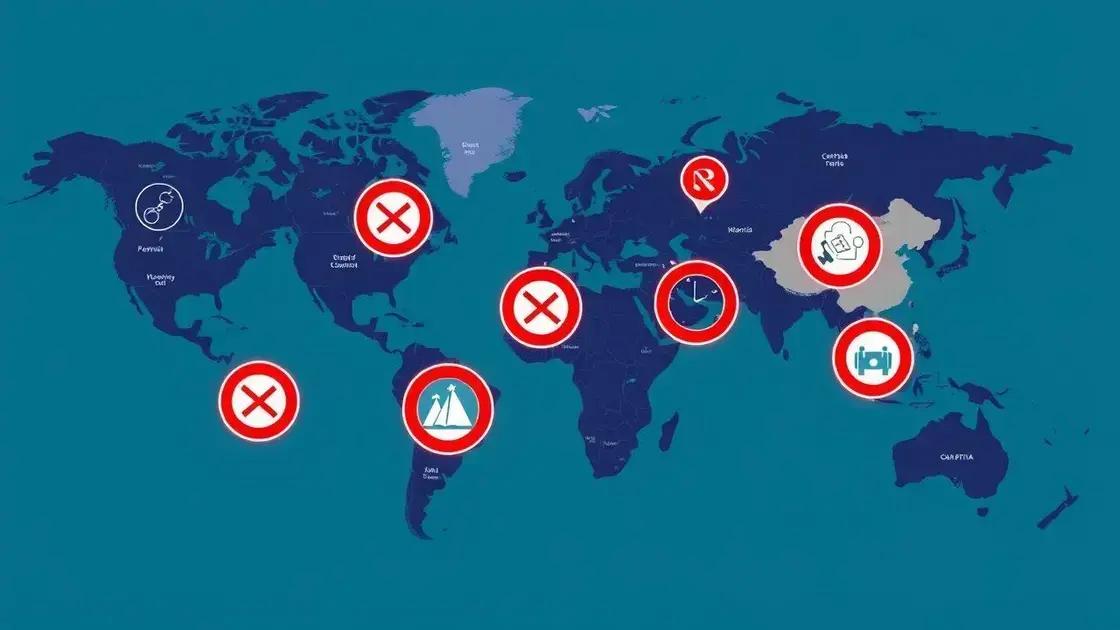Technology export restrictions and impact on global trade

Technology export restrictions impact global trade by limiting technology transfer, disrupting supply chains, and necessitating compliance strategies, while promoting sustainability within export policies.
Technology export restrictions have become a significant topic as countries seek to protect their technological assets. These restrictions influence global trade and innovation, raising questions about the future of international collaboration.
Understanding technology export restrictions
Understanding technology export restrictions is essential in today’s global economy. These regulations control how specific technologies and products can be traded internationally, impacting innovation and collaboration among nations.
Governments often implement these restrictions to protect national security, economic interests, and intellectual property. The motives behind these regulations vary, but they significantly shape the landscape of international trade.
Reasons for Technology Export Restrictions
Several factors contribute to the enforcement of technology export restrictions. Each plays a crucial role in how countries navigate global commerce.
- National Security: Protecting sensitive technologies from falling into the wrong hands is a top priority.
- Economic Strategy: Nations may restrict exports to strengthen their own industries or retaliate against trade partners.
- Protection of Intellectual Property: Export controls help safeguard innovations made by domestic companies.
As technology advances, the need for clarity around these regulations increases. Companies must remain informed about current laws to ensure compliance and avoid penalties. Understanding the differences between various types of export controls is vital for businesses that operate internationally.
Types of Export Controls
Export controls can be categorized into several types, which help delineate the scope of restrictions applicable to different technologies.
- Dual-Use Items: Technologies that can be used for both civilian and military applications are often closely regulated.
- Military Exports: Products intended for military use typically face stricter controls than civilian items.
- Restricted Entities: Certain organizations or countries may be subject to specific restrictions based on their activities.
Understanding these categories aids companies in efficiently navigating compliance requirements. Staying informed and adaptable is key to maintaining a successful international business strategy where technology export restrictions are concerned.
Key impacts on global trade

The key impacts on global trade from technology export restrictions are significant and broad-reaching. These regulations can alter trade relationships, affect supply chains, and influence market dynamics in various ways.
When a country imposes restrictions, it can limit the availability of certain technologies in markets around the world. This restriction may lead to supply shortages for businesses that rely on these technologies for production. In turn, this can drive prices up, affecting consumers and the cost of goods.
Challenging Supply Chains
Technology export restrictions challenge supply chains, causing delays and increased costs. Companies need to be aware of which products are restricted and how these restrictions can affect their operations.
- Increased Costs: As companies look for alternative suppliers or materials, their costs may rise significantly.
- Delays in Production: Restrictions may lead to unexpected delays that can halt production lines.
- Market Uncertainty: Traders face uncertainty when markets change quickly, often requiring rapid strategic adjustments.
Understanding the effects of these restrictions is crucial for businesses engaged in international trade. Companies need strategies to mitigate risks associated with sudden changes in export regulations.
Shifts in Global Alliances
Technology export restrictions can also shift global alliances. As countries impose restrictions, new partnerships may form, aiming to bypass these barriers. For instance, nations may strengthen ties to secure access to critical technologies. These shifts can alter existing trade agreements and create new economic alliances.
Market players must adapt to these changing alliances. By staying informed and agile, businesses can pivot to align with emerging trends and collaborations that arise from export restrictions.
Challenges for businesses navigating restrictions
Challenges for businesses navigating restrictions can be complex and frustrating. As technology export restrictions become more prevalent, companies face various obstacles that impede their operations.
One major challenge is keeping up with constantly changing regulations. Export restrictions can vary significantly between countries and can change quickly, often without much warning. This creates uncertainty for businesses that must stay compliant to avoid hefty fines.
Compliance Costs
Ensuring compliance with technology export restrictions can be expensive. Businesses must invest in legal and compliance teams to help interpret regulations and develop suitable policies.
- Training Employees: Companies often need to train their staff on compliance issues, which can take time and resources.
- Legal Fees: Hiring legal counsel to navigate complex regulations can lead to increased operational costs.
- Monitoring Changes: Companies must continuously monitor changes in regulations, adding to the workload of compliance teams.
These costs can be burdensome, particularly for small and medium-sized enterprises (SMEs) that may not have extensive resources available. Even larger corporations find these challenges daunting as they scale operations internationally.
Supply Chain Disruption
Another significant challenge is the potential for disruptions in the supply chain. When companies face export restrictions, their ability to acquire essential components may be affected.
This can lead to production halts, delays, and increased costs. Businesses must often seek alternative suppliers or materials, which may not always be readily available. These shifts can also impact the overall quality of products made.
To manage these challenges, businesses should consider developing strategic partnerships and diversifying their supplier base. By doing so, they can create more resilient supply chains that can adapt to restrictions and changes in the industry.
Future trends in technology export policies

Future trends in technology export policies are increasingly relevant as the global landscape of trade evolves. Governments are re-evaluating their approaches to technology exports, driven by considerations of national security, economic competition, and technological innovation.
One key trend is the growing emphasis on protecting intellectual property and critical technologies. Countries are adopting more stringent regulations to ensure that their innovations remain secure from foreign exploitation. As technology becomes a fundamental part of national security, we can expect stricter controls to emerge.
Shifts in Regulatory Frameworks
As technology continues to advance, regulatory frameworks are likely to shift. Governments may develop new policies that address emerging technologies such as artificial intelligence, quantum computing, and biotechnology.
- Specific Regulations for AI: Policies may focus specifically on the ethical and secure use of artificial intelligence, ensuring that these technologies are not misused.
- Greater International Cooperation: Countries may collaborate more on export policies to address common concerns about cybersecurity and technology transfer.
- Streamlined Compliance Processes: To support businesses, some governments might simplify compliance procedures regarding export restrictions.
These changes can provide businesses with new opportunities and challenges. Companies that stay ahead of these trends will be better positioned to adapt and thrive in a dynamic market.
Increased Focus on Sustainability
Another emerging trend is the increased focus on sustainability within technology export policies. As global awareness of environmental issues rises, nations may adjust their policies to promote sustainable tech practices.
Businesses will likely need to demonstrate their commitment to sustainability when exporting technologies. This requirement can drive innovation, as companies work to reduce their environmental impact while still complying with export restrictions.
In summary, staying informed about these future trends can help businesses navigate the complex landscape of technology export restrictions and leverage new opportunities.
In conclusion, understanding the landscape of technology export restrictions is crucial for businesses operating in today’s global economy. By keeping an eye on trends, companies can adapt to new regulations and challenges. As policies evolve, businesses must be proactive in implementing compliance strategies to thrive. Additionally, the focus on sustainability presents both challenges and opportunities, encouraging innovation in technology practices. In this ever-changing environment, staying informed and agile will be key to navigating the complexities of global trade.
FAQ – Frequently Asked Questions about Technology Export Restrictions
What are technology export restrictions?
Technology export restrictions are regulations that limit the transfer of certain technologies across national borders to protect national security or economic interests.
How do export restrictions impact global trade?
Export restrictions can disrupt supply chains, increase costs, and shift international alliances as businesses adapt to changing regulations.
What should businesses do to comply with export regulations?
Businesses should stay informed about regulations, invest in compliance training, and consider consulting legal experts to navigate complexities.
How are sustainability practices linked to export policies?
There is a growing trend for governments to incorporate sustainability into export policies, requiring companies to ensure their practices are environmentally friendly.





